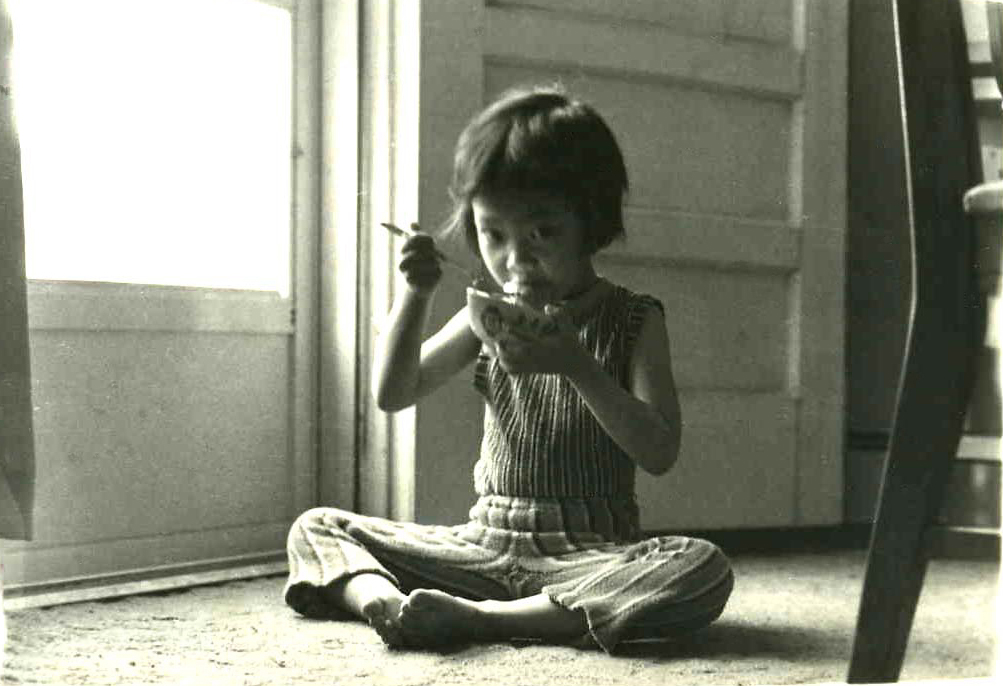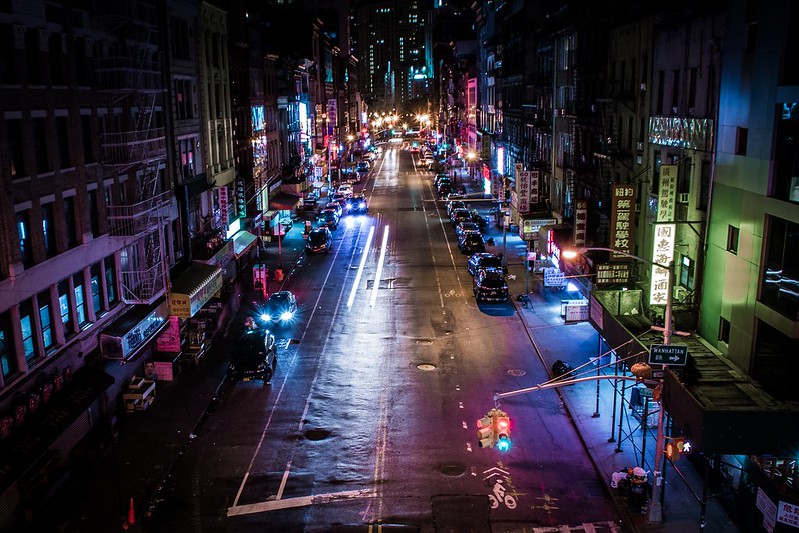Amid the sea of Chinese characters in Sunset Park’s Eighth Avenue, an Irish pub has held its ground despite waves of inward and outward migration.
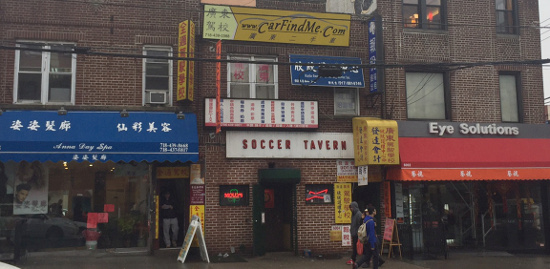
March 29, 2016
Every time I walk by the Soccer Tavern on Eighth Avenue in Sunset Park, I always feel very curious. It looks a little out of place with the rest of the neighborhood. Eighth Avenue – from 62nd street to 45th street – is known as Brooklyn’s Chinatown, dominated by Chinese-run shops. The whole area is covered in Chinese characters. So why is there an Irish pub right in the middle of this bustling Chinese American neighborhood?
In comparison to the hundreds of Chinese signs jutting out into the street around it, the Soccer Tavern’s sign is just an unassuming set of letters above its door. It stands between an optometrist and a day spa. On the second floor above the bar is Haylie Excellent Consulting Service Inc. and the Canton Driving School. All are marked with bright, colorful Chinese characters.
In contrast, Soccer Tavern has a simple facade: a red brick wall and a nondescript green door, flanked by two small windows with neon beer signs. It looks very secretive, like it might be concealing something.
It is the only remaining Irish bar in the neighborhood, having been established almost 85 years ago. It now coexists with the Chinese American community. One can’t help but wonder how it has remained so unchanged after all this time. What is its staying power?
Opening the door to the bar is like walking into a time machine. Or perhaps more like the Woody Allen film, “Midnight in Paris.” Am I going to be transported back to a forgotten era?
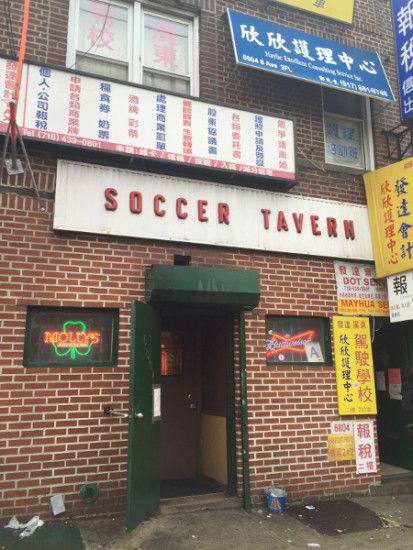
On a Sunday at 3 p.m., there are about five to six Caucasian patrons sitting next to the bar, drinking and chatting. They toast, take a sip, then slowly put down their bottles and share anecdotes about life.
Across the the bar, there are two high, round tables where six or seven Chinese customers are sitting, younger than the bar denizens but still middle-aged. Unlike the quiet conversations at the bar, the Chinese group is animated, each of them offering toasts, laughing and checking their cellphones as well as the game on the TV screen.
Most of these customers are regulars who have lived in this area for a long time.
They say Eighth Avenue was once a bar street
One bar regular who did not want to be named for this story says 50 years ago, when he was 9 years old, he used to be a shoe shine boy, holding a small shoe box and running up and down the bustling Eighth Avenue. Every weekend, he would make the trip to Eighth Avenue to shine shoes for those going to the bars, one knee down on the floor of the bar. He was always hustling — from 60th Street to 40th Street and then back down again – night after night.
“To shine a pair of shoes cost 25 cents. In one night you could earn a few bucks,” he recalled.
“From the early 19th century to the early 20th century, Eighth Avenue was strictly a Scandinavian immigrant community. It was called ‘Little Norway’, or sometimes ‘Lapskaus Boulevard,’ after the famous Norwegian beef stew.”
At that time, it was mostly Norwegians and Irish who were filling the bars. Who would have thought 50 years later, the Scandinavians would be gone and the people sitting around him now are almost all Chinese. How many of them even know this used to be a bar street?
However, the bar client who did not want to be named for this story has every scene deeply etched in his mind. He remembers the good old days. “Because I’ve always been here; I never left,” he says.
Even after several decades, many of the bar habitues never seemed to have left this neighborhood; it’s as if they stayed here forever. Even those who did leave eventually came back. Like Frank McNamarra.
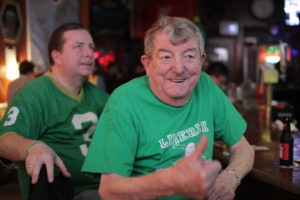
Forty-five years ago, Frank bought a house on 54th Street and 7th Avenue. He bought it for $25,000. He and his family lived in the neighborhood for 45 years. Then, last year, he sold his home for $1.3 million and moved to Staten Island with his son. Every Sunday, however, he comes back here to drink and watch the game.
“I take the bus from Staten Island a few times a week. This is like my home,” he says.
This group of old-timers witnessed the changing of Eighth Avenue over the years. From as far as they can recall, Eighth Avenue has been their favorite hangout. According to Scandinavian museum archives, there were at least 11 bars in the five short blocks between 54th and 59th Streets in 1942: Eric’s Place, Nightcap, The Pool Hall, Kallevig’s Bar, Carl’s Bar, Harry’s Bar, Terry’s Bar, Ruving’s Bar, Gjøa Clubhouse, Matchbox Bar and Grill, and Duffy’s Tavern.
In fact, from the early 19th century to the early 20th century, Eighth Avenue was strictly a Scandinavian immigrant community. It was called “Little Norway”, or sometimes “Lapskaus Boulevard,” after the famous Norwegian beef stew. The R train was even known as the “Norwegian-American line.”
Most of these immigrants were sailors working along the waterfront from Bay Ridge to Sunset Park. After a long day’s work, the sailors and longshoremen loved to go to Eighth Avenue to drink. Most of them were single.
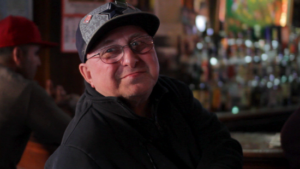
“Back then, we could go bar-hopping on Eighth Avenue and drink until every bar closed,” says Louie Dybo, one of the regulars at Soccer Tavern.
Another customer, Jason Xie, says, “you can go check it out, almost all of the banks on Eighth Avenue used to be a bar.”
That wild scene seems to have been washed away without leaving a trace.
Armed with the addresses of some the former bars along the avenue, I went out and tried to locate them and see what became of them. Harry’s Bar and Gjøa Clubhouse are now both seafood markets; The Pool Hall and Ruving’s Bar are now Chinese restaurants and Kallevig’s Bar is a shopping mall.
Fifty years after, the neighborhood has become unrecognizable to the older generation. For many newer or younger residents, the wild bar street is an almost unbelievable scene. And Soccer Tavern is the only remnant of those days.
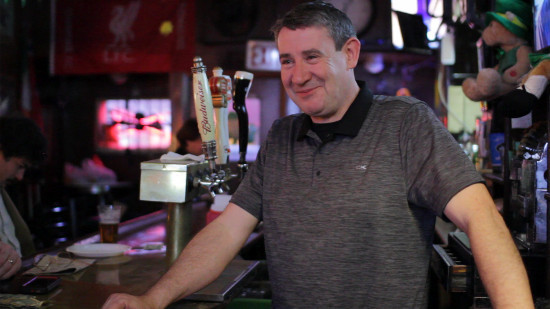
The owner, Brendan Farley, tells me that “almost nothing changed in here.” Since its first day of business 85 years ago, the wooden bar itself has never been replaced. The walls are covered with old photographs, awards, and memorabilia from years past. Up until last year, the old jukebox picked out actual vinyl records to play for the customers. In a far corner, a coin-operated telephone still rings.
Where have all the bars gone?
In 1960, the discovery of oil saw Norway’s economy turn for the better. Many Norwegians made the move back to their home country in hopes of more financial stability. Some of them moved to Pennsylvania and New Jersey. Until the early 1960s, Sunset Park’s main population was made up of immigrant Irish, Italians, Germans, as well as some lingering Nordic Americans. These groups began leaving the neighborhood during the 1970s and 1980s due to a faltering city economy.
“Eighth Avenue was a favored destination; in Chinese culture, eight is a lucky number, indicating prosperity. In 1986, the first Chinese-American grocery store, Winley Supermarket, was opened at the corner of Eighth Avenue and 56th Street.”
They were replaced by immigrants from Puerto Rico, Dominican Republic and other Latin American and Caribbean countries, who flocked to the neighborhood in search of cheap apartments. At present, nearly nothing remains of the original Norwegian character of Eighth Avenue. Homes and businesses formerly owned by Norwegians have been bought by a new wave of Chinese immigrants.
At the same time, across the river in Manhattan, Chinatown was becoming congested. More established Chinese immigrants began seeking refuge from the high real-estate prices in the city and started to follow the convenient N train to the lower property costs of Sunset Park.
Eighth Avenue was a favored destination; in Chinese culture, eight is a lucky number, indicating prosperity. In 1986, the first Chinese-American grocery store, Winley Supermarket, was opened at the corner of Eighth Avenue and 56th Street. Since then, more Chinese have settled along and around Eighth Avenue, giving rise to Brooklyn Chinatown.

As a result of this influx, real estate prices in the neighborhood skyrocketed and many bar owners have sold their businesses. The traditional patrons left along with the other bars, but Brendan chose to stick it out. He has worked at Soccer Tavern since he was 19. “I only know how to tend bar,” he confesses. For him, 30 years passed in the blink of an eye.
In 1986, he was an immigrant to America from Ireland. Brendan met his first wife in this bar. Since then, he set down his roots. His customers are also immigrants: from the original Norwegians to Germans and Italians, Puerto Ricans and more recently the Chinese people. In Soccer Tavern today, half the regulars are Irish, half are Chinese.
“Customers make the bar,” he says, and since 1990 most of the new ones have been Chinese.
You can see the demographics change in the bar’s darts league. On the old trophies, there were only Irish and Norwegian surnames. It was not until 1999 that a Chinese surname appeared. Today, half the members of the league are Chinese.
The first Chinese to join the darts competitions was Jason Xie. He had participated in the Bay Ridge darts tournament for almost 10 years. In 2006, his second year in the tournament, he won the championship.
He began to patronize the bar 20 years ago and often comes here to drink and play darts with friends.
He says, “the atmosphere here is like, everyone converged.”
In fact, there are other Chinese-style entertainment options, KTV and bars on Eighth Avenue. However, Jason thinks people here are relatively simple. They don’t make any trouble, even without a guard standing by the door. If only Chinese customers hung out in this bar, maybe he would not come here.
Yap Yoon Choy, from Malaysia, said: ” People are more friendly in here, do I do not want to get into trouble.”
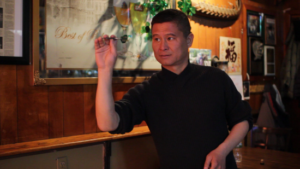
When Jason and Yap first came, they were bachelors, just looking for a place to drink and hang out. For them, Soccer Tavern is the first stop on the way home. After work, they come out from the N train subway station, and swing by the bar to see who is drinking here. On most nights, they get a quick drink and then head home. But sometimes when they’ve been chatting late, they head next door to the restaurant for dinner or even into the street, where they buy some chicken or lamb skewers. They bring it back to the bar and snack on them while drinking.
On Sundays, many people come to watch the soccer game. Brendan prepares free food: roast pork, baked beans, fried rice, etc., “It’s like a family here, so that everyone can enjoy the game. If you like sports, then everybody gets along.” He said.
Brendan also provides soy sauce, Tabasco sauce, or the sweet chili sauce Sriracha, tell-tale signs of the bar’s openness to a multicultural community. He also hung a Chinese calendar and has newspaper articles in Chinese posted on the wall by the bar.
Who says there can’t be Asian culture in an old Irish bar?
The first time Brendan tried Chinese food, was in a small, family-owned cafe on 58th Street and it was the only Chinese restaurant on Eighth Avenue then. He used to go there for lunch. He’s developed a taste for Chinese cuisine and learned to cook some simple dishes that he offers to his Chinese clientele. It all comes down to his Irish hospitality: he wants to make everyone welcome.
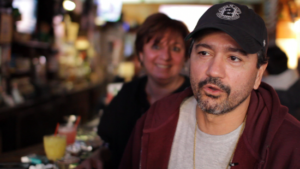
Louie Dybo is Native American. He was born in the neighborhood and 69 years later, he still lives on 60th Street. Speaking of the different ethnic groups, he jokes: “You have already interviewed Irish customers and Chinese, now you have to interview the Puerto Ricans.” In his eyes, the Chinese customer chat so noisily it sounds like they are in a fight.
He asked: “Do you also speak so noisy?”
“In fact the Chinese are very friendly, they only fight with other Chinese, they won’t bother others,” he says with a laugh.
Luis Fuentes was born in Puerto Rico and migrated to the United States in 1972. He moved to Eighth Avenue and enrolled at the local junior high. At that time, there were only two Chinese kids in his class and both of them were his good friends.
But now, the whole street has turned Chinese. The community has changed and the old Irish pub seems to be undergoing a quiet revolution.
For this year’s Lunar New Year, there were lion dances and a roast pig in the bar, which was covered with all kinds of New Year blessings and ornaments. On St. Patrick Day, the Tavern served Irish corned beef and bar customers drank endless beers. In the summer, bar loyalists held a reunion at the racetrack. For those events, old customers came back and reminisced together about the good old days.
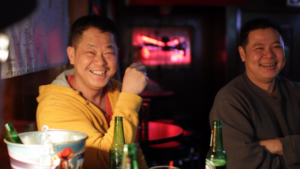
When you ask the newer neighbors if they know that Eighth Avenue once had a raucous nightlife, most have no idea. They only know that there is a single “foreigner” bar next to the N train station. For nearly a century, this Irish pub has stood quietly in the middle of a constantly changing community.
As I open the door and stepped out of what seems like a time tunnel, there are so many impressions of the old days that linger in my mind. Though the whole world outside has changed, the Soccer Tavern has stood the test of time; its survival a testament to its resilience and adaptability.

